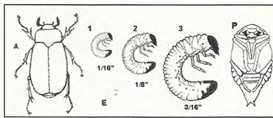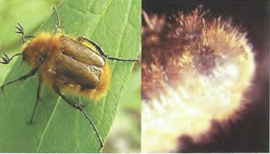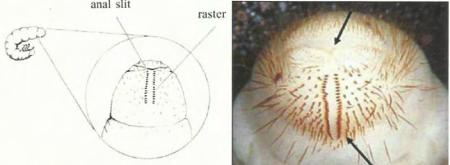Cranberry Soil Insects Scarab Beetles 2011
Bog sections that are infested with root-feeding insects at first show weakness, and as the vines die, they turn dark orange. Lighter orange, more recently-injured vines may circle the dead areas that fill in with weeds (Figure 2). Problems are most likely to show up on vine edges and well drained bog areas. Stress on the root-injured vines, e.g. following drought or applications of some herbicides, may cause rapid vine death. In the case of the scarab grub group, because the roots have been eaten away, and the soil area below the vine somewhat packed down by the action of the grubs' movement, the vines pull up easily and may roll back like a layer of turf (Figure 3). Often, the grubs will be right below the vine, but when it has been cold or dry, they may move further down.

Figure 1. Life stages of a typical white grub. The cranberry white grub (Phy/lophaga) is shown here, with the three larval instars (center). The larva's head width is given in inches (e.g. the head width of the huge third instar is 3/16" across). Adult beetle (A), egg (El, and pupa (P). (Diagram: North Dakota Extension Service).
Oriental Beetle
Anomala orientalis (Waterhouse)
Oriental beetle is increasingly common in cranberry. There is little or no feeding in the adult stage so only the root feeding of the larva is a problem.
Biology and Description
The full-grown grub reaches a length of ¾ inch. Oriental beetle larvae look just like small cranberry white grub larvae. They can be identified by the hair pattern on the underside of the abdomen and the anal slit. There are two parallel rows of stout hairs, with l 0-16 hairs in each row and the anal slit is shaped like a weak arch at the end of the abdomen.The oriental beetle typically has one generation/year, with a small portion taking two years. The larvae overwinter in the soil and migrate toward the soil surface when temperatures reach about 50°F in the spring; the larvae then feed on roots for between one to two months before pupating.


Figure 4. Oriental beetle is small, about 3/8 inch long (figure not to scale). This lineup shows the variation in color; most adults have dark markings (center) but some are all straw-colored or all black.
Adult emergence begins in mid-June, peaks mid July, and may continue into August in highly infested areas. Adults may be difficult to locate. However, the oriental beetle sex pheromone has been identified, and if a commercially-available lure is taken to an infested bed, male beetles will immediately be attracted to the pheromone source. Beetle activity peaks between 6-10 p.m. Virgin females begin calling (i.e. releasing sex pheromone) upon emerging from the soil. Mated females immediately burrow into the soil. Eggs are laid (ca. 25 total) mostly in a very small radius from a female's point of emergence from the soil. Infestations of the oriental beetle are typically patchy and injury to vines may radiate outward over the years.

Figure S. Oriental beetle adult, showing one more color pattern (compare to Figure 4).
Cranberry Root Grub
Lichnanthe vulpina Hentz
This is a native species that has long been a pest of MA cranberry. It is in the family Glaphyridae, the 'bumble bee scarab beetles.' During bloom, the adult beetles fly close to the ground and could be mistaken for bees because of their coat of yellow hair. When looked at closely, both the adults and larvae are quite different from the three other 'white grub' species.
Biology and Description
We believe that it takes the larvae 4-5 years to complete development, so when sampling, various sizes of larvae can be found together in the soil. They feed on roots mostly 3-4 inches from the surface, but as the bog becomes drier over the smnmer, the larva may go deeper in the soil. The mature larva forms a prepupa in the middle of May. Adults emerge in middle to late June, peak during bloom, and can be seen until the 2nd - 3rd week of July. Adults spend most of their time in the soil and may emerge early in the morning, often on the mornings heavy with dew. The females climb up on the foliage and release a sex pheromone; attracted males zig-zag upwind over the vines when they pick up the plume of odor.
The cranberry root grub is the only grub found in beds that is covered with soft hairs. When full grown, the larva is ca. 1 inch long with short reddish brownish hairs (Figure 7 and 13). The larval body is flattened from top to bottom. These traits distinguish cranberry root grub from the other species of soil scarabs. The beetle is ½-5/8 inch long with dark brown wings. The beetle is covered with a coat of hair; the female's is lemon yellow and the male's coat is bright golden to golden-reddish (Figure 7).

Figure 7. Left: Male cranberry root grub adult; owing to color and behavior (buzzing low over the vines), it resembles a bumble bee. This is a very bright specimen. (Photo: Kerry Yurewicz, BugGuide). Right: Underside of cranberry root grub larva is covered in hairs with no distinct raster pattern, which helps tell it apart from the other soil grubs.
Cranberry White Grub
Phy/lophaga anxia LeConte
The adult of the cranberry white grub and other members of its beetle family are commonly called May or June beetles because the majority of adult flight activity in this group occurs during those months. Cranberry white grubs are often found in high areas near bog edges, but infestations have been seen throughout a bed.
Biology and Description
The adults are large (7/8 inch) and the hardened forewings are shiny black to chestnut-brown (Figure 8). Adult flights begin in early to mid May and may last until the end of June. Adults emerge from the soil at dusk and feed on the foliage of a variety of plants, but are not lcnow11 to feed on cranberry. Mating takes place at night. Mated females deposit ca. 55 eggs.

Figure 8. Adult cranberry white grub (Phyllophaga) adult is in the group called 'June bugs,' which are best known as the large, loud beetles that bumble around when attracted to porch lights in early evening. (Photo: Joe Ogrodnick, NYSAES, Cornell).
Newly-hatched larvae feed on decaying vegetation, and fungal hyphae rather than roots. After 6-8 weeks, they molt into 2nd instars, which begin root-feeding. At the end of Year 1, the 2nd instars burrow deeper into the soil to overwinter. In the spring of the Year 2, they feed for a short time before the final molt. This 3rd instar is the most damaging, owing to its large size. Upon attaining sufficient size (which may occur in either Year 2 or 3), the 3rd instar creates a cavity in the soil and pupation takes place in August. Adults remain in these cavities and emerge to fly in early to mid May of the following year. Thus, the life cycle (Figure 1) takes from 3-4 years depending on local conditions and latitude.
Hoplia Equina
Leconte
This is a small native species of scarab beetle that was fairly recently discovered as a root feeding problem in cranberry during the 1990s. The species was only correctly identified ca. a decade later. The adult has not been observed feeding on the vines.

Figure 10. Hoplia equina beetle is dull brownish.
Biology and Description
Adults emerge and are active at bloom, from mid June to mid-July. The adult (Figure 10) is dull brown and ca. 5/16 inch long. We have seen high adult activity in the late afternoon, when many beetles emerged at once, some forming clusters of several males attempting to mate with a single female. The larva (Figure 13) undergoes three instars and is a c-shaped white grub that can be distinguished from the other white grubs (cranberry white grub and oriental beetle grub) by the Y-shaped anal slit and V shaped pattern of stout hairs on the underside of the abdomen (Figure 12). It is likely that larvae take two years to complete development.
Japanese Beetle
This species is not known to be a pest of cranberry.

Figure 11. Left: The shape of the anal slit together with the pattern of stout hairs in the raster are used in identification. Both traits arelocated on the underside of the grub's last segment. Right: Raster and anal slit of cranberry white grub (Phylfophaga). (Photo: Michigan State University)

Figure 12. Raster and anal slit patterns for the three similar-appearing white grubs in cranberry.

Figure 13. Comparison of the final (3rd) instar of the white grub species. Japanese beetle is not found in cranberry. (Photo: Joe Ogrodnick and Paul Robbins, NYSAES, Cornell)